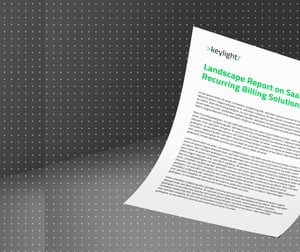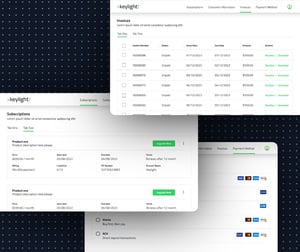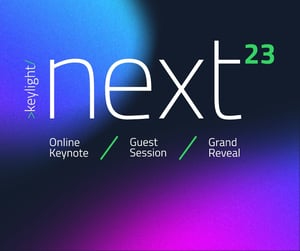Explore AI’s commercial potential
A growing market
The use of Artificial intelligence (AI) and machine learning is not only sweeping our social and home lives, but is increasingly driving change in businesses. As with any advancement however, knowing how to use it, and knowing how to use it productively are not the same thing.
AI can be exciting, flashy and impressive, but for businesses, the challenge is to use it effectively, and preferably for commercial gain. That might mean reducing overheads through more streamlined processes, or even proactively monetising its capabilities.
In this article we look at the opportunity created by AI for subscription businesses, and some of the ways you can actively capitalise on it.
AI-related functionalities hold immense potential for acquiring new customers and driving revenue growth.
Definition
What is AI?
AI is the science of making technology 'think' by using large amounts of data, alongside human knowledge, to power systems so they can categorize information, make predictions, identify mistakes, analyze information and even communicate similarly to humans.
AI relies on data as well as technologies to make things happen
- Machine Learning (ML) is based on algorithms that make predictions based on data.
- Deep learning allows for the automation of tasks without human intervention.
- Natural Language Processing (NLP) enables technology to recognize, understand and generate text and consequently speech.
In businesses, AI can be used in lots of different areas of business, such as
- IT operations
- Marketing and Sales
- Customer service
- Cybersecurity
- Supply chain management
Staying competitive
AI and a competitive landscape
According to McKinsey & Company, the use of artificial intelligence in business operations has doubled since 2017, a trend that's only set to increase as businesses make it a focus for investment (in 2022 63% said they expect their organizations’ investment to increase over the next three years).
They also noted: "A set of companies seeing the highest financial returns from AI continue to pull ahead of competitors. The results show these leaders making larger investments in AI, engaging in increasingly advanced practices known to enable scale and faster AI development, and showing signs of faring better in the tight market for AI talent."
That sets the scene for how important AI is not only within a business and its own operations, but also in terms of where businesses need to be in relation to their competitors.
Optimize workflows
How can AI benefit businesses?
Artificial intelligence is used as a tool to support a human workforce by optimizing workflows and making business operations more efficient. Their applications are continuously evolving at pace, which means there will be an ever-increasing array of opportunities and benefits that it can offer.
As things stand, AI advancements can already help reduce the amount of time it takes for employees to do their work thanks to simplified processes, which make problem-solving easier and quicker whilst also relieving them of repetitive tasks.
This gives team members more time to focus on more fulfilling work that’s better suited to human intelligence, not only leading to greater productivity but greater job satisfaction amongst team members, improving the chances of employee retention. These primary benefits have remained fairly constant since the advent of AI.
Ways in which AI can benefit businesses
- It can optimize business functions.
- It can boost employee productivity through automation.
- It can drive business value and improve user experience through predictive service and intervention.
Additional areas of potential for many companies
- The creation of new AI-based products or product enhancements
- Product feature optimisation
- Risk modeling and analytics
- Improved customer segmentation and analytics
- Improved customer acquisition
Implement a strategy
How do you use AI effectively?
As with all things, to use AI effectively, you must have a strategy, and that begins with truly understanding not only what you do, but what customers value about what you do and where the gaps are.
Gathering the data you need
Data is really the foundation of effective AI, which means that you need to make sure the systems you have in place gather the data that you need, organize it and use it in a way that's helpful. That means it not only needs to be secure (both practically and in line with regulations) and trustworthy, but continuously updated and reviewed.
For example, keylight offers end-to-end data collection in a complete ecosystem that allows subscription businesses to follow customers throughout the entire customer journey and understand their interactions with the business. It treats user-centric events as atomic events, and that captures them in a system that allows for comprehensive and structured data collection so you can see the correlation between them.
Using data to your best advantage
Once you have the required information, you need a system that enables you to do what you want without being inhibited by the technology itself, forcing you to make compromises that undermine your objectives and the service you provide.
Thanks to keylight's robust mathematical backbone, every concept, set of logic, process, and component is designed from the outset to be available for data analytics and statistical insights. As a result, you can then use the information as you need it, with continuous learning readily available at your fingertips.
In addition, keylight’s API-first approach allows the front-end, user facing side of your subscription platform and the back-end system to talk to one another seamlessly.
This approach makes the system easy to work with, enabling you to get what you need for your subscription requirements. As a result, you can take actions tailored to the requirements of your business and your customers, quickly, so you can rapidly respond to market needs.
Implement a strategy
How can you monetise AI?
To monetise AI you really have to understand what its great potential is, and this truly lies in its ability to process enormous amounts of information more efficiently, more accurately and much faster than any human. Then, enabling AI monetization requires advanced subscription technology to deliver a coherent user experience along with the convenience of AI.
Three commonly recognised pillars to monetising AI
- Free trials and usage metering: Letting customers experience the convenience of AI, the ability to accurately track and record service consumption in real time gives you the ability to bill accordingly for a highly transparent service.
- Flexible price components: Bundling AI services with existing products gives you the flexibility to test pricing that drives the most sign-ups and revenue.
- Billing: In a modern approach to billing, you can more accurately invoice and charge customers through flexible pricing plans combining usage-based, seat-based, and fixed-rate elements together, ensuring maximum fairness and leveraging metered usage.
One of the key things to note with AI is that it's not simply a tool but part of a transformative approach to business, and this mindset is central to monetising its potential. With that in mind, within a purpose-created subscription platform, some of the immediate ways in which you can monetise AI are as follows:
AI and the customer journey
Streamlining the customer journey is crucial to AI monetisation, from the initial sign up experience to how the internal workflow may reflect back to the customer after purchase experience. For example, how easy is it for customers to manage their subscription (upgrade, pause and cancel), monitor their usage and manage their payments?
- The impact on sales when monetising AI: It captures the service value and minimises the effort needed to get started through trials, flexible pricing and cancellation.
-
The impact on subscription management when monetising AI: Offering flexible pricing requires good contract management and automation capabilities, especially if selling AI services with existing products. Therefore, contract hierarchy, billing cycles and revenue recognition all need to be streamlined.
- The impact on customer retention when monetising AI: You can implement an automated cancellation journey if a customer does decide to leave. This can be carefully curated to benefit your business, whatever the outcome. By offering incentives and problem solving you may be able to make the customer reconsider leaving. By learning from the customer's pain points you can make changes to improve the experience for future customers. By enabling customers to leave on a positive note you leave the door open if they ever want to return.
AI pricing models
Pricing is one of the most powerful areas of the business in which you can really monetise the potential of AI, by enabling more sophisticated options that suit customers better and that operate seamlessly. It's crucial if you offer things like free trials and user-based options that billing and processes are entirely accurate—something which requires the system to 'think' like a human but avoiding the inevitable errors that would occur if this type of daily task was left to a human workforce. As a business grows, and the frequency of transactions increases, not only would a human approach to this capability be riddled with errors, but it would also be costly to implement to the point of rendering the business unscalable. Options to enable AI pricing in keylight include:
- Free trials: You might wish to offer free trials to entice new customers, making it important that your system is able to accommodate different initial terms and that it moves across to the next stage of billing seamlessly as required.
- Subscriptions with multi-dimensional metrics: Without smart pricing options you're likely to be limited to a very simple billing option offering basic plans and premium plans without many variables. That can work for a while but it limits your growth potential and your market reach.
- Quantity based charges: This might be per user or per volume, for example.
- Usage based: Also referred to as a pay-as-you-go model, keylight will enable you to monitor usage events for accurate billing and positive user experiences.
- Pre-paid: This might be volume based, but it needs to make it easy for customers to purchase more availability once the prepaid usage is up.
- Hybrid AI pricing models: You can also combine all the options above within a subscription framework to offer flexible, customized pricing based on insights from your customer base.
AI billing services
We have written before about how essential communications are around billing, and while it seems like a purely transactional process, it's also central to the customer relationship. Getting it right can profoundly influence customer retention as well as the practical success of collecting payments themselves.
keylight can support those positive outcomes by streamlining the experience, such as telling customers when they will be billed and how much, notifying them of failed payments and dunning retries, as well as triggering workflows to make sure payments aren't missed and customers aren't lost through something avoidable. Features might include:
- Automated emails and notifications.
- Accurate invoice templates.
- Payment reminders, renewal notifications and payment notice periods.
- Internally, AI will support monitored events for usage, billing, payments and identify overdue invoices to streamline internal workflows.
Implement a strategy
How keylight supports AI monetisation in your subscription business
keylight is the ultimate, modern and comprehensive technology foundation, designed to enable you to launch, transform and scale new business models. When it comes to supporting the monetisation of AI in subscription businesses, keylight helps in three ways:
-
The speed to launch. It has comprehensive features that require no custom development. There’s no need to invest a large sum before profit, or sacrifice the experience for the ‘initial phase’ of the AI monetisation project.
-
The flexibility of its design allows you to work with other software as you require, without difficult integration processes. It also allows you to go through the essential motions of testing, so you can test and personalize AI experiences from the customer journey to billing, to make sure it works seamlessly.
-
It gives you all the tools and capabilities for gathering the essential data you need to make AI work effectively for your business.

Power your business
with the right subscription solutions
![]() Book a free consultation
Book a free consultation
Power your business
with the right subscription solutions
![]() Book a free consultation
Book a free consultation

Explore keylight's superior value compared to conventional subscription platforms
![]() Compare now
Compare now
Explore keylight's superior value compared to conventional subscription platforms
![]() Compare now
Compare now




